Watercolor painting is a delicate art form that combines transparency and fluidity, offering unique creative possibilities. It requires balance between control and unpredictability, making each piece distinctive and captivating, blending technique and spontaneity for expressive results.
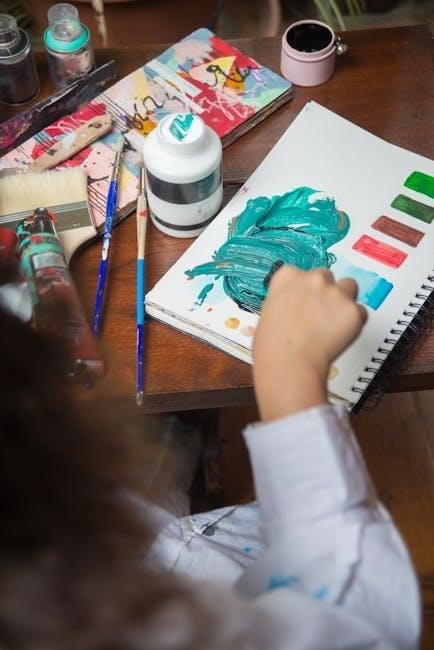
Essential Materials for Watercolor Painting
To begin with watercolor painting, you’ll need a few key materials. Start with high-quality watercolor paints, available in pan or tube form, ensuring lightfast pigments for durability. Natural hair brushes, like sable or squirrel, are ideal for water retention and blending. Synthetic brushes are a cost-effective alternative and still perform well. Invest in watercolor paper, preferably 140lb (300gsm) or heavier, with a textured surface (cold press) for better pigment absorption. A porcelain palette is recommended for mixing colors, as it resists staining. Additional tools include masking fluid, a spray bottle, paper towels, and a pencil for sketching. Optional items like watercolor pencils or crayons can add unique effects. Always choose materials that suit your skill level and budget to enjoy the creative process without compromise.
Basic Watercolor Painting Techniques
Mastering basic techniques like wet-on-wet, wet-on-dry, and washes is fundamental. These methods allow for blending, layering, and achieving vibrant colors. Practice these skills to build confidence and control, ensuring a solid foundation for more complex works. Start with simple exercises to explore how water and pigment interact on paper, gradually refining your approach through consistent experimentation and study of these core techniques.
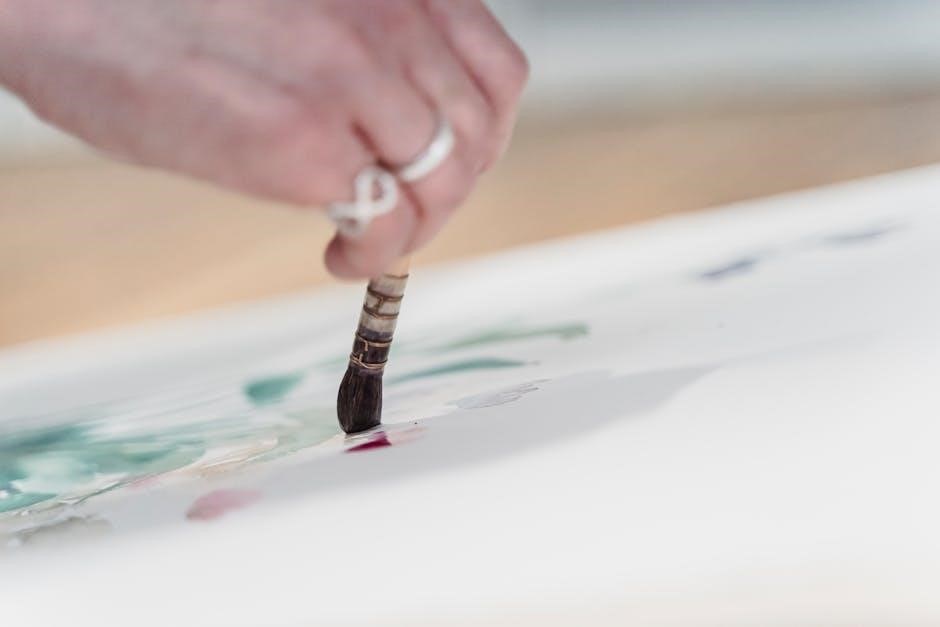
3.1. Wet-on-Wet Technique
The wet-on-wet technique involves applying wet paint to wet paper, creating soft blends and subtle color transitions. Start by moistening the paper with clean water, then load your brush with paint and apply it directly. This method allows for organic merging of colors, ideal for backgrounds, skies, and delicate subjects. The paint diffuses naturally, producing ethereal effects. Work quickly, as the paper dries fast. This technique is perfect for achieving soft edges and dynamic, spontaneous results. It’s a foundational skill for capturing movement and light in watercolor art. Practice this method to master fluidity and blending in your paintings.
3.2. Wet-on-Dry Technique
The wet-on-dry technique involves applying wet paint to dry paper, enabling sharp, defined edges and precise control. Start by allowing the paper to dry completely or use a hairdryer to speed up the process. Load your brush with paint and apply it to the dry surface. This method is ideal for creating crisp lines, detailed work, and layered compositions. It’s commonly used for subjects like flowers, architecture, or intricate patterns. The paint adheres to the paper without bleeding, allowing for clean, deliberate strokes. This technique is excellent for building up colors gradually and achieving vibrant, saturated hues. Practice wet-on-dry to refine your ability to create sharp contrasts and detailed artwork in watercolor painting.
3.3. Washes
A wash is a thin, transparent layer of paint applied evenly to the paper, creating soft, uniform areas of color. It’s often used for backgrounds like skies or water. To achieve a wash, mix pigment with plenty of water, then sweep your brush across the paper in smooth, continuous strokes. Wet-on-dry or wet-on-wet techniques can be employed. Wet-on-dry ensures crisp edges, while wet-on-wet blends colors softly. Washes are foundational in watercolor, allowing light to reflect through the paint, enhancing luminosity. They’re perfect for capturing subtle shifts in tone and mood. Practice varying wash thickness and color saturation to master this essential technique, which adds depth and harmony to your watercolor paintings.
Color Theory for Watercolor Artists
Color theory is fundamental to watercolor painting, guiding how pigments interact and harmonize. Understanding hue, value, and saturation helps create balanced compositions; Hue refers to color itself, while value is its lightness or darkness, crucial in watercolors for depth and contrast. Saturation determines color intensity. Transparent watercolors rely on the white paper for luminosity, so mastering color mixing is essential. A color wheel aids in selecting complementary, analogous, or triadic schemes for visual impact. Cool colors like blues and greens recede, while warm colors like oranges and reds advance. Glazing layers of transparent paint can deepen hues and achieve rich, vibrant effects. Properly balancing these elements enhances the emotional resonance of your work, making color theory a vital tool for watercolor artists to craft stunning, expressive paintings.
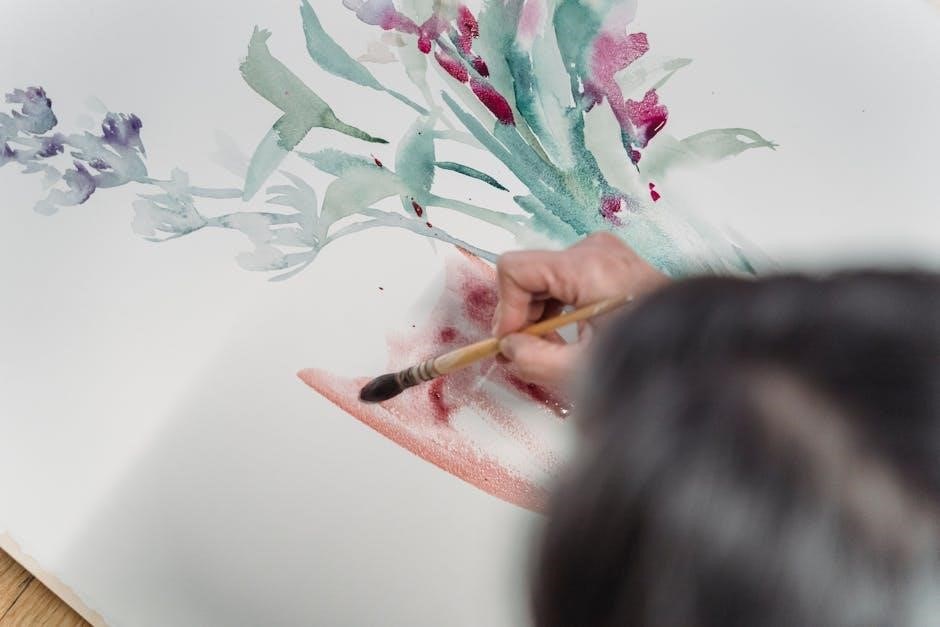
Advanced Watercolor Techniques
Advanced techniques include glazing, masking fluid, and combining wet-on-wet with wet-on-dry for texture. These methods add depth, preserve whites, and enhance detail, pushing creative boundaries in watercolor art.
5.1. Glazing
Glazing is a sophisticated watercolor technique that involves layering multiple thin, transparent washes to achieve deep, vibrant colors and intricate details. By allowing each layer to dry completely before adding the next, artists can create rich, luminous hues that are difficult to attain with single applications. This method is particularly effective for capturing subtle shifts in color tone and for enhancing the sense of depth in a painting. Glazing requires patience and careful planning, as each successive layer builds upon the previous one. It is ideal for subjects like landscapes, portraits, and still lifes, where complexity and nuance are desired. Proper pigment choice and water ratios are essential for optimal results.
5.2. Masking Fluid
Masking fluid, also known as masking medium or frisket, is a vital tool in watercolor painting for preserving areas of the paper from unwanted color. Applied with a brush or tool, it creates a protective barrier that resists water and pigment. Once dry, the fluid can be painted over, and the masked areas remain pristine. It is particularly useful for maintaining white spaces, creating sharp edges, or protecting delicate details. After painting, the masking fluid is gently rubbed off with a finger or eraser, revealing the untouched paper beneath. Proper application is key to avoiding peeling or damage to the paper. Masking fluid is indispensable for intricate compositions, such as botanicals or portraits, where precision and detail are essential. It allows artists to plan and execute complex works with confidence and control.
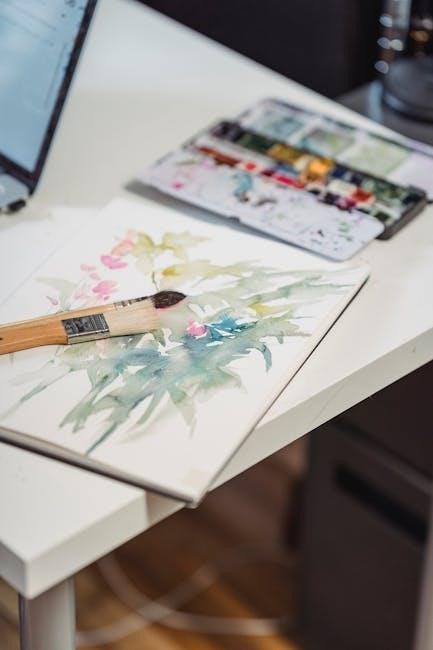
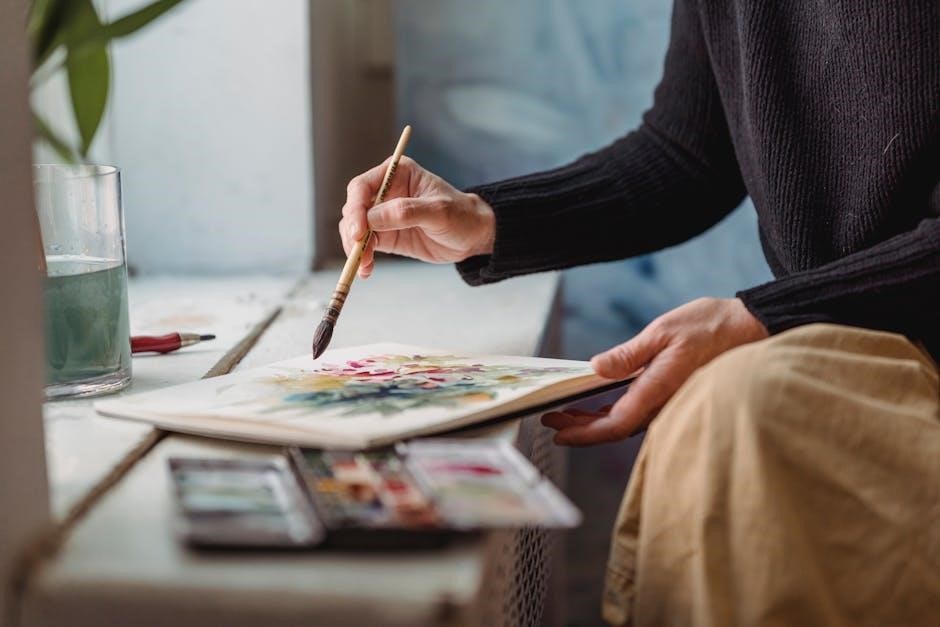
Practicing Watercolor Techniques
Practicing watercolor techniques regularly is essential to mastering the medium. Start with simple exercises like creating washes, mixing colors, and experimenting with wet-on-wet and wet-on-dry methods. Begin with basic shapes and gradients to build control and confidence. As you progress, incorporate more complex compositions, such as still lifes or landscapes, to apply techniques in context. Use reference images to study light, color, and form. Practice lifting and correcting mistakes to refine your skills. Dedicate time to explore advanced methods like glazing and masking fluid. Consistent practice helps develop intuition and fluidity, allowing you to express your artistic vision effectively. Remember, patience and persistence are key to improving your watercolor painting abilities.
Common Mistakes to Avoid
When learning watercolor painting, several common mistakes can hinder progress. Overmixing colors on the palette can lead to muddy tones, while using too much water results in weak, washed-out hues. Applying too many layers without allowing previous ones to dry can cause unwanted textures or peeling. Neglecting to plan the composition before starting often leads to disorganized and unbalanced artwork. Using low-quality materials, such as cheap brushes or non-watercolor paper, can frustrate the process and affect results. Additionally, rushing the painting process or not allowing washes to dry properly can ruin the subtle, transparent effects watercolor is known for. Being mindful of these pitfalls helps artists achieve more control and satisfaction in their work.
Applying Techniques to Different Genres
Watercolor techniques adapt beautifully to various artistic genres, from landscapes to portraits and still life, each requiring unique approaches to capture their essence effectively and elegantly.
8.1. Landscapes
Watercolor landscapes thrive on capturing light and atmosphere. Techniques like wet-on-wet and wet-on-dry are essential for blending skies and creating soft, gradient backgrounds. Using washes allows artists to depict vast, open spaces with minimal detail, focusing on mood rather than precision. Layering transparent pigments enhances depth, while masking fluid can preserve white areas for highlights like clouds or water reflections. Glazing adds richness to foliage and distant mountains. The unpredictability of watercolor suits landscapes, where subtle shifts in color and texture evoke natural scenes. Practicing these methods helps artists achieve the ethereal quality that makes watercolor landscapes so captivating and unique.
8.2. Portraits and Figurative Art
Watercolor portraits and figurative art demand precision and subtlety to capture human expression and form. Artists often use layering techniques to build skin tones, employing thin washes and glazing for depth. Wet-on-dry is ideal for detailed features, while wet-on-wet can soften facial contours. Masking fluid helps preserve fine details like eyes or hair. Balancing transparency and control is key, as watercolor’s fluidity can enhance emotional expression. Practicing gestural brushstrokes and refining color harmony are essential for dynamic figurative compositions. The medium’s unpredictability adds a unique charm, making each piece personal and expressive, while challenging the artist to master both technique and spontaneity in portraying the human figure.
8.3. Still Life Paintings
Watercolor still life paintings offer a unique opportunity to explore texture, form, and composition. Artists often use wet-on-wet and wet-on-dry techniques to layer colors and achieve depth. Transparent washes can highlight glass or fabric, while controlled brushstrokes define shapes. Masking fluid is useful for preserving intricate details like patterns or reflections. The spontaneity of watercolor adds vitality to still life setups, allowing for playful experimentation with light and shadow. Practicing techniques like glazing and washes helps capture the essence of everyday objects. Still life paintings in watercolor encourage creativity and precision, blending the medium’s unpredictability with deliberate artistic expression to create visually engaging and thought-provoking works of art.
Using Watercolor Pencils and Crayons
Watercolor pencils and crayons offer unique possibilities for creating detailed, layered artworks; Unlike traditional watercolors, these tools allow artists to sketch and draw directly onto paper before activating pigments with water. Caran d’Ache Supracolor pencils are a popular choice for their vibrant, lightfast colors, while watercolor crayons like those from DSmith provide bold, expressive marks. Both tools excel at adding texture and precision to paintings. Wet-on-wet and wet-on-dry techniques can be adapted for pencils and crayons, enabling intricate layering and blending. Masking fluid can also be used to preserve fine details. These mediums bridge drawing and painting, offering artists versatility and control. Experimenting with watercolor pencils and crayons opens new creative avenues, combining the spontaneity of watercolor with the precision of drawing tools.
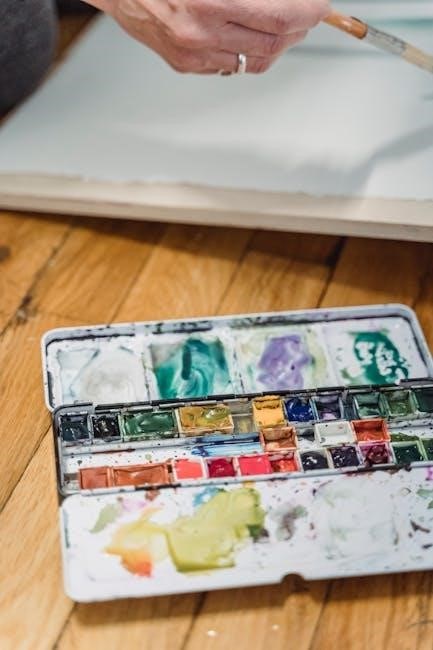
The Role of Paper in Watercolor Painting
Watercolor paper is the backbone of watercolor painting, influencing both technique and final results. Its texture, weight, and absorbency determine how pigments interact with the surface. High-quality papers, often labeled as “rag” or “cotton,” are durable and resist buckling under water. Weights like 140lb or 300lb indicate strength, with heavier papers handling more water. Textures range from smooth hot press to rough cold press, each suited for different styles. Properly prepared paper, sometimes stretched and taped, ensures stability during painting. The paper’s ability to hold washes and maintain vibrancy is crucial, as it directly impacts the luminosity and longevity of the artwork. Choosing the right paper is foundational to achieving desired effects in watercolor painting.
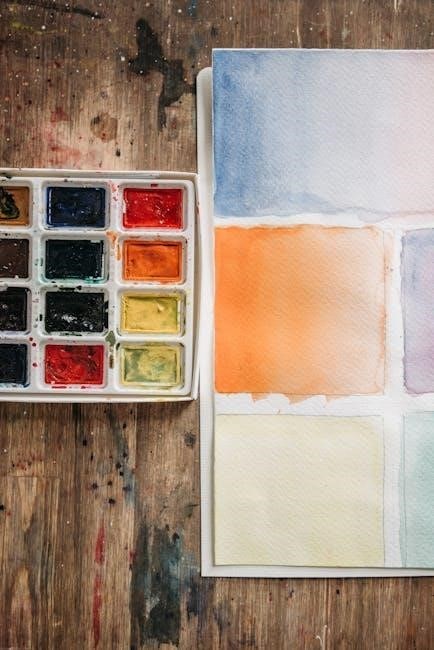
Tips for Beginners
Starting with watercolor painting can be intimidating, but with the right approach, beginners can quickly build confidence. Begin by practicing basic washes and simple exercises to understand pigment and water ratios. Use high-quality paper and brushes to ensure better results. Experiment with color mixing and blending techniques on scrap paper before applying them to your main work. Reference images can guide composition and color choices. Don’t fear mistakes—watercolor’s unpredictability is part of its charm. Clean your brushes thoroughly after each session to maintain their quality. Watch tutorials and join online communities for inspiration and feedback. Most importantly, enjoy the process and embrace the medium’s unique challenges and rewards.
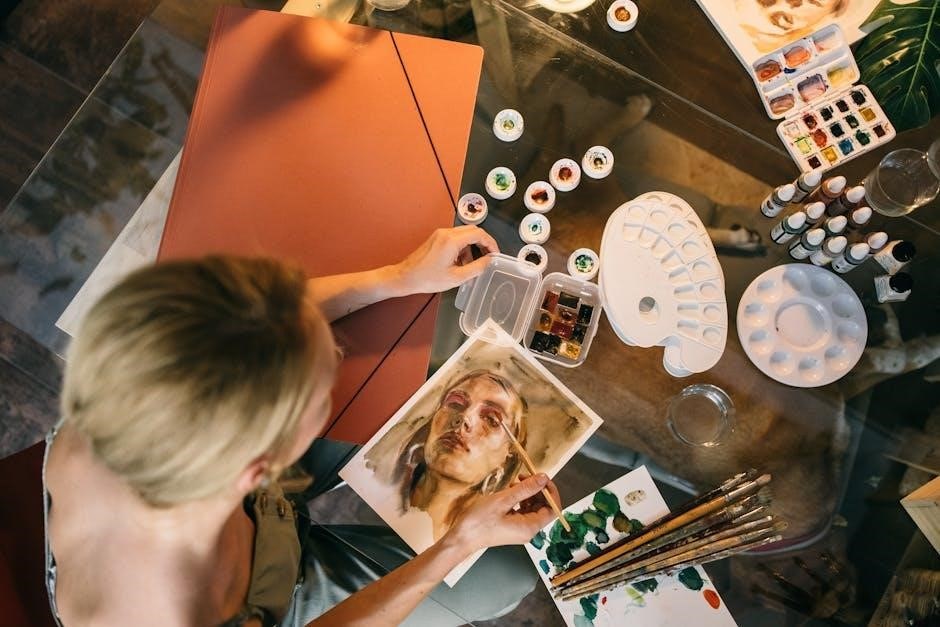
Mastering Watercolor Techniques in Two Weeks
Mastering watercolor techniques in two weeks requires dedication and consistent practice. Start with basic exercises like simple washes and wet-on-wet techniques to build foundational skills. Dedicate the first few days to understanding pigment and water ratios, as this is crucial for achieving desired effects. Progress gradually to more complex methods like glazing and masking fluid. Allocate specific days to practice wet-on-dry and wash techniques, ensuring each skill is refined before moving forward. Use reference guides or tutorials to follow structured lesson plans. By the end of two weeks, focus on applying these techniques to small, complete paintings. Consistency and patience are key to rapid improvement in this medium.
The Importance of Pigment and Water Ratios
The balance between pigment and water in watercolor painting is crucial for achieving desired effects. Pigment-to-water ratios determine the transparency, vibrancy, and texture of strokes. A higher water content creates lighter, more transparent washes, while more pigment results in bold, opaque colors. Understanding these ratios is essential for mastering techniques like wet-on-wet and glazing. Proper ratios ensure consistency and prevent unwanted muddiness or over-saturation. Experimenting with different proportions helps artists control the subtlety and depth of their work, making it a fundamental aspect of watercolor mastery. This balance is key to creating dynamic, expressive paintings that capture the medium’s unique qualities;
Mastering watercolor painting techniques requires patience, practice, and a deep understanding of the medium. By exploring essential methods like wet-on-wet and wet-on-dry, artists can unlock the unique possibilities of watercolor. The key to success lies in balancing pigment and water, experimenting with materials, and embracing the medium’s unpredictability. Whether you’re a beginner or an advanced artist, consistent practice and a willingness to learn will enhance your skills. Watercolor painting offers a world of creative expression, blending spontaneity with control. As you continue your journey, remember to stay curious, experiment freely, and enjoy the process of creating something truly special with every brushstroke.
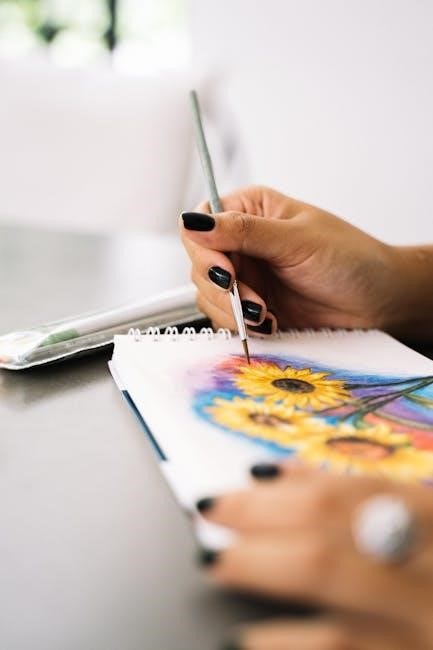
Additional Resources
For further exploration, numerous resources are available to deepen your understanding of watercolor techniques. Books like Creative Watercolor Techniques and The Watercolour Artist’s Handbook offer comprehensive guides. Online platforms provide downloadable PDFs, such as Watercolor Impressions and Basic Watercolor Painting Techniques Worksheet. Websites like watercolor.org and arttutor.com host tutorials and courses. Communities like WetCanvas and watercolor forums share insights and inspiration. Additionally, free guides like Watercolor Secrets and Mastering Watercolor Techniques in Two Weeks are invaluable. These resources cater to all skill levels, from beginners to advanced artists, ensuring continuous learning and growth in the art of watercolor painting.

